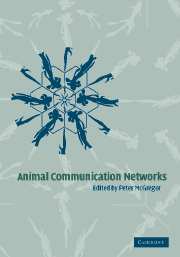Book contents
- Frontmatter
- Contents
- List of contributors
- Preface
- 1 Introduction
- Part I Behaviours specific to communication networks
- Part II The effects of particular contexts
- Introduction
- 7 Enlightened decisions: female assessment and communication networks
- 8 Predation and noise in communication networks of neotropical katydids
- 9 Nestling begging as a communication network
- 10 Redirection of aggression: multiparty signalling within a network?
- 11 Scent marking and social communication
- Part III Communication networks in different taxa
- Part IV Interfaces with other disciplines
- Index
8 - Predation and noise in communication networks of neotropical katydids
Published online by Cambridge University Press: 06 August 2010
- Frontmatter
- Contents
- List of contributors
- Preface
- 1 Introduction
- Part I Behaviours specific to communication networks
- Part II The effects of particular contexts
- Introduction
- 7 Enlightened decisions: female assessment and communication networks
- 8 Predation and noise in communication networks of neotropical katydids
- 9 Nestling begging as a communication network
- 10 Redirection of aggression: multiparty signalling within a network?
- 11 Scent marking and social communication
- Part III Communication networks in different taxa
- Part IV Interfaces with other disciplines
- Index
Summary
Introduction
Intraspecific acoustic communication in grasshoppers or katydids appears to be a very simple and straight forward behaviour: one sex – usually the male – produces an acoustic signal, and the female, once perceiving and recognizing the signal as species specific, shows some kind of response, either an acoustic reply or a phonotactic movement to the male. However, the system is far from being that simple and involves more than just a sender and receiver. First, communication usually takes place in a physically complex environment, where sound signals are subject to attenuation and degradation, depending on the carrier frequencies, which are often in the high-sonic or ultrasonic range because of the small size of the sound radiating structures (Wiley & Richards, 1978; Michelsen, 1992). In addition, the physical conditions of the transmission channel for the sound may vary strongly during day or night and with weather conditions; consequently, the ability to detect and localize a signal undergoes strong variations. Second, insects often aggregate and communicate in areas rich in resources or at periods of the day or night favouring mate attraction. As a result of many signallers calling in close proximity, masking interference will take place at the site of receivers, depending on the spacing, as well as the kind and extent of signal timing. Since such favourable areas and times for signalling are similar for different species, heterospecific choruses may be formed with impressive sound pressure levels of biological background noise, which further complicates the detection of a signal (reviewed for katydids by Schatral (1990)).
Information
- Type
- Chapter
- Information
- Animal Communication Networks , pp. 152 - 169Publisher: Cambridge University PressPrint publication year: 2005
Accessibility standard: Unknown
Why this information is here
This section outlines the accessibility features of this content - including support for screen readers, full keyboard navigation and high-contrast display options. This may not be relevant for you.Accessibility Information
- 29
- Cited by
